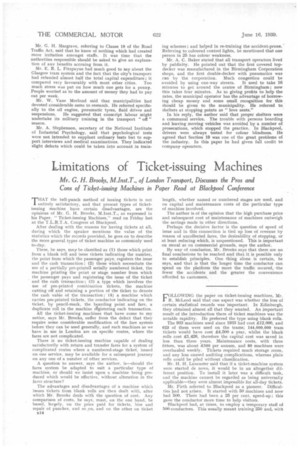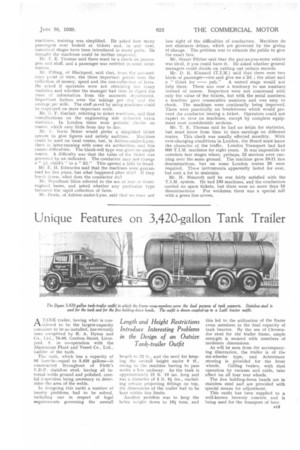Limitations of Ticket-issuing Machines
Page 48

Page 49

If you've noticed an error in this article please click here to report it so we can fix it.
Mr, G. H. Brooks, M.Inst.T., of London Transport, Discusses the Pros and Cons of Ticket-issuing Machines in Paper Read at Blackpool Conference
THAT the bell-punch method of issuing tickets is not 1 entirely satisfactory, and that present types of ticketissuing machine have certain disadvantages, are the opinions of Mr. G. H. Brooks, M.Inst.T., as expressed in his Paper, "Ticket-issuing Machines," read on Friday last at the T.L.R.T.A. Congress at Blackpool.
After dealing with the reasons for having tickets at all, during which the speaker mentions the value of the statistics which the records provided, he goes on to describe the more general_ types of ticket machine as commonly used to-day.
These, he says, may be classified as (1) those which print from a blank roll and issue tickets indicating the number, the point from which the passenger pays. registers the issue and the cash 'transaction; (2) those which necessitate the use of a partially pre-printe3 serially numbered ticket, the machine printing the point or stage number from which the passenger pays and registering the issue of the ticket and the cash transaction; (3) a type which involves the Use of pre-printed combination tickets, the machine cutting off and retaining a portion of the ticket to denote the cash value of the transaction:. (4) a machine which carries pre-printed tickets, the conductor indicating on the ticket, by pencil-mark, the boarding point and fare, a duplicate roll in the machine rtgistering each transaction.
All the ticket-issuing machines that have come to my notice, says Mr. Brooks, suffer from the defect that they require some considerable modification of the fare system before they can be used generally, and such machines as we have in use in London are on specific routes, where the fares are not complicated.
There is no ticket-issuing machine capable of dealing satisfactorily with return and transfer fares for a system of complicated routes where a numbered-stage ticket, issued on one service, may be available for a subsequent journey on any one of a number of other services.
A question to answer, says the author, is—should the fares system be adapted to suit a particular type of machine, or should we insist upon a machine being produced which would be effective, without alteration in the fares structure?
The advantages and disadvantages of a machine which issues tickets from blank rolls are then dealt with, after which Mr. Brooks deals with the question of cost, Any comparison of costs, he says, must, on the one hand, be based, largely, on the price paid for tickets, hire and repair of punches, and so on, and on the other on ticket al4 length, whether named or numbered stages are used, and on capital and maintenance costs of the particular type of machine involved.
The author is of the opinion that the high purchase price and subsequent cost of maintenance of machines outweigh the savings made in other directions.
Perhaps the decisive factor is the question of speed of issue and in this connection is tied up loss of revenue by reason of uncollected fares, the desirability of stopping, or at least reducing which, is unquestioned. This is important on moral as on commercial grounds, says the author.
By way of conclusion, Mr. Brooks says that there are no final conclusions to be reached and that it is possible only to establish principles. One thing alone is certain, he says, and that is that the longer time the conductor can spend on the platform the more the traffic secured, the fewer the accidents and the greater the convenience afforded to customers.
FOLLOW1NG the paper on ticket-issuing machines, Mr. R. McLeod said that one aspect was whether the loss of certain statistical records was important. In Edinburgh, they obtained almost all that they wanted. An important result of the introduction there of ticket machines was the notable rapidity. He preferred the type using blank rolls.
The 933 machines used since 1933 had cost £12,000, and 623 of them were used on the trams; 144,000,000 tram tickets Would have cost £4,500 a year, whilst the blank rolls cost £1,426, therefore the capital cost was saved in less than three years. Maintenance costs, with three fitters, was about £500 per annum, and 80 machines were overhauled weekly. Tickets required much storage room, and any loss caused auditing complications, whereas plain rolls could be piled without classification.
Mr, H. H. Lancaster said that if a ticket-machine system were started de nova, it would be in an altogether different position. To install it later was a difficult task, and the machine cannot be regarded as being universally applicable—they were almost impossible for all-day tickets.
Mr. Firth referred to Blackpool as a pioneer. Difficulties bad not arisen. It started with 50 machines and now had 500. There had been a 25 per cent. speed-up; this gave the conductor snore time to help visitors.
Blackpool had, at times, to employ a temporary staff of 500 conductors. This usually meant training 250 and, with
machines, training was simplified. He asked how many passengers ever looked at tickets and. in any case, numerical stages have been introduced in many parts. He thought the machines could be further improved.
Mr. T. E. Thomas said there must be a cheek on passengers and staff, and a passenger was entitled to some information.
Mr. Pilling, of Blackpool, said that, from the accountancy pcint of view, the three important points were the collection of money, speed and the non-collection of fares. He asked if operators were not obtaining too many statistics and whether the manager had time to digest the mass of information from the accounts department. Important factors were the takings per day and the average per mile. The staff saved by using machines could be employed on more important work.
Mt. G. F. Sinclair, referring to ticket machines, said that complications on the engineering side debarred extra statistics. In London there were periodic checks on routes, which vary little from day to day.
Mr. C. Irwin Baker would prefer a simplified ticket
system to give figures and satisfy auditors. Machines could he used on local routes; but, in Ashton-under-Lyne. there is inter-running with some six authorities, and this causes difficulties. The blank-roll type was good on simple routes. A difficulty was that the value of the ticket was governed by an indicator. The conductor may not change a "d. child's " to a " 2d." This opened a field to fraud.
Mr. E Edwardes said that the machines were guaranteed for five years, hut what happened after this? If they break down, what does the conductor do?
Mr, Wyndham Shire referred to the use of rear or frontengined buses, and asked whether any particular type favoured the rapid collection of fares, Mr. Davis, of Ashton-under-Lyne, said that we must not
lose sight of the difficulties of conductors. Machines do not eliminate delays, which are governed by the giving of change. The problem was to educate the public to give the exact fare.
Mr, Stuart Pitcher said that the pay-as-you-enter vehicle was idea], if you could have it. He asked whether genera] managers could decide on cutting out certain records.
Mr. D. K. Kinnard (T.I.M.) said that there were two kinds of passenger—one said give me a 2d. ; the other said a " ticket for — pub." A named stage would not help there. There was now a tendency to use numbers instead of names. Inspectors were not concerned with only the value of the tickets, but with the serial numbers; a machine gave consecutive numbers and was easy to check. The machines were continually being improved. There were practically no breakdowns which would prevent the conductor issuing a ticket. Operators could not expect to save on machines, except by complete equipment over considerable sections.
MT. T. E. Thomas said he had no fetish for statistics, but must know from time to time earnings on different routes. This check was usually effected monthly. With ever-changing conditions in London, the Board must know the character of the traffic. London Transport had had 800 T.I.M. machines for eight years. It was impossible to correlate fare stages where, perhaps, 12 services were running over the same ground. The machine gave 10-11 fare denominations, but on some London routes 28 were required. These instruments apparently lasted for ever, but cost a lot to maintain.
Mr. H. Muscroft said he was fairly satisfied with the system. Ile had 180 machines, and the conductors carried no spare tickets, but there were no more than 10 denominations For workmen there was a special roll with a green line across.




















































































